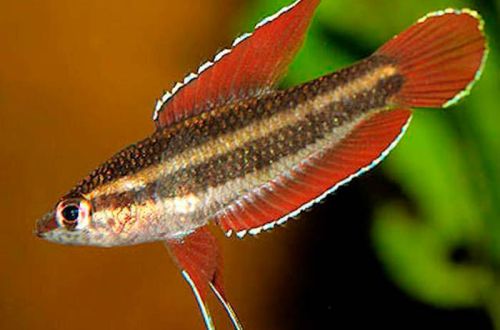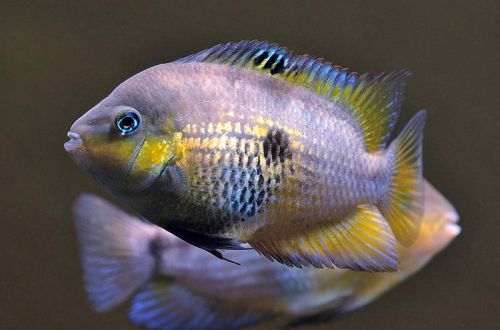
Parosfromenus anjunganensis
Parosfromenus anjunganensis or Kupanus anjunganensis, scientific name Parosphromenus anjunganensis, belongs to the Osphronemidae family. The fish got its name from the area near which it was discovered, namely the city of Anjungan. It is considered not an easy fish to keep due to the high requirements for the composition of the water and the small size of adults, which significantly limits the number of compatible species.

Contents
Habitat
It comes from Southeast Asia from the Indonesian part of the island of Borneo. The natural habitat roughly coincides with the boundaries of the province of West Kalimantan. Inhabits peat bogs and associated rivers located among tropical forests. A typical biotope is a dimly lit reservoir with dense coastal vegetation, the bottom of which is covered with a thick layer of fallen leaves, branches pierced by many roots. The water has a rich brown hue due to the high concentration of humic acids and other tannins formed as a result of the decomposition of plant organic matter.
Brief information:
- The volume of the aquarium – from 30 liters.
- Temperature – 22-28°C
- Value pH — 3.0–6.5
- Water hardness – 1–5 dGH
- Substrate type – any dark
- Lighting – subdued
- Brackish water – no
- Water movement – little or no
- The size of the fish is about 3 cm.
- Food – live or frozen food
- Temperament – peaceful
- Content – in a group of relatives or with other small species
Description
Adult individuals reach a length of about 3 cm. This species is characterized by pronounced sexual dimorphism. Males in contrast to females look brighter with a more intense color palette. The body has a striped pattern of alternating horizontal dark and light stripes. Dorsal, anal and caudal fins are reddish-brown with a thin bluish edging. Females are less colorful, have a similar body pattern, but do not have reddish fins.
Food
Carnivorous look. The basis of the diet should be live or frozen foods, such as bloodworms, brine shrimp, daphnia, etc. Dry food is not recommended, fish usually refuse such a diet.
Maintenance and care, arrangement of the aquarium
The optimal size of the aquarium for one or two fish starts from 20-30 liters. In the design, it is desirable to repeat the features of the natural habitat: a subdued level of lighting, numerous shelters made of snags and thickets of shade-loving plants, mosses, ferns, a layer of leaf litter on a dark substrate. The use of the leaves of some trees is not only part of the natural decor, but also affects the chemical absorption of water due to the release of tannins during the decomposition process. Due to this, the water acquires a characteristic brown color. Read more in the article “Which tree leaves can be used in an aquarium.”
When keeping Parosfromenus anjunganensis, it is very important to ensure and maintain very low pH and dGH values. You may need to install reverse osmosis or use other methods to obtain soft water. More on this in a separate article. The style of the aquatic environment depends on the smooth operation of the equipment and the regularity of certain mandatory aquarium maintenance procedures: weekly replacement of part of the water (5–10% of the volume) with fresh water, timely removal of organic waste, etc.
Filtration should not be too strong, sometimes a simple airlift filter is enough. It is the filtration system that is the main cause of the internal current, and the fish are poorly adapted to life in conditions of strong water movement. This must be taken into account.
Behavior and Compatibility
Peaceful calm fish. Feels great in the company of relatives and other species of comparable size that can live in a similar environment, such as rasboras, some small barbs and others. Any large aquarium neighbors should be excluded.
Breeding / breeding
Under favorable conditions, successful cases of breeding are quite possible. With the onset of the breeding season, the male occupies a site at the bottom of the aquarium, the center of which is some kind of shelter, and proceeds to courtship. When the female accepts courtship, the couple proceeds to spawn, accompanied by a kind of “courtship dance”, during which the fish turn head down and cling to each other. Parents pick up each portion of fertilized eggs and carry them to the shelter, attaching them to the roof of the cave. Then the female swims away, and the male remains to protect the masonry. The incubation period is 24-36 hours. After another 4-6 days, the fry begin to swim freely. Gradually, parental instincts weaken and the male soon ceases to pay attention to his offspring.
Fish diseases
A well-established biological system, a balanced diet and the absence of stressful situations (for example, being chased by aggressive fish) are the best guarantee of maintaining health. When the first signs of an illness appear, first of all, attention should be paid to these three factors, perhaps there was a deviation in one of them. As a rule, solving the problem leads to self-healing. However, if the immune system fails, you will have to resort to medical treatment. Read more about symptoms and treatments in the Aquarium Fish Diseases section.





